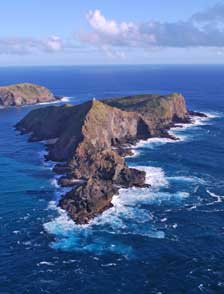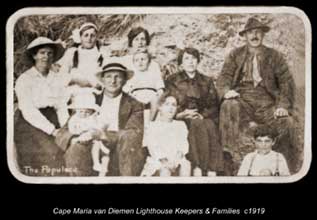Archive of Past Events and Exhibitions
FREEMASONS ARCHIVE
7 - 31 August 2018
We are delighted to announce that the Freemasons of Mangonui - Kaitaia have generously gifted their archive collection to Museum@Te Ahu. One of the earliest lodges to be established in New Zealand, the Mangonui Lodge is over 125 years old and its early members were some of the most well-known characters in Kaitaia’s history.
The Freemasons is part of an international group steeped in ancient traditions and rituals with its origins in Europe. Men who worked as stonemasons building castles and cathedrals formed this organization over 300 years ago, its purpose to protect their specialist engineering skills and pass them on to worthy apprentices.
The first lodge in New Zealand was founded in 1842 and by 1890 the Freemasons of New Zealand was established. By 1891, eleven members lived in the Mangonui/Kaitaia district and petitioned for a lodge. On 27th April 1892, the Mangonui Lodge was opened.
We are very honoured that this collection has come to the Museum @ Te Ahu for safe keeping whilst the Mangonui Lodge goes mobile.
Some of the items in the collection will be on display in the museum from Tuesday 7 August to Friday 31 August 2018. Spread the word and drop in to see them before they are moved into our archives.
MATARIKI 2018
29 June to 27 July 2018
A big thank you to all who visited the Museum@Te Ahu during Matariki. The Māori cloaks displayed in the 'Tuia te kākā, Whatu te kākahu - Stories woven into cloaks' exhibition were a real success. They drew local families and other visitors in to see the skilled work of weavers and also enjoy the stories we shared. We had over 2000 people come into the museum in June and July.
We are also happy to report that a korowai feathered cloak has been gifted on a long term loan and will be held at the museum. We are most grateful to the donor for their generosity. Once it has been treated, it will replace the 1897 korowai which has been on display at the museum for six years. This will have conservation work done before it is carefully stored away for a rest.
The exhibition included a collection of different types of kākāhu (traditionally-made clothing) on display during the Matariki season.
Here are three Korowai - Maori Woven Cloaks - which are currently on display at Museum @ Te Ahu. Come and read all about their individual histories while you admire the beautiful handiwork that has gone into making them.
We have lunchtime talks at Museum @ Te Ahu, orated by community curator, Awhina Goulton, and Museum Curator, Whina Te Whiu. The talks will be given twice a day from Tuesday 17th to Friday 20th July inclusive, from 12.00 noon to 12.45pm and from 1.00pm to 1.45 pm. All are welcome to come and learn more about these wonderful exhibits.
ANZAC DAY 2018
The museum was open on ANZAC Day (Wednesday 25 April) from 8.30am until 4.30pm - normal Museum hours.
There is also a display, in Te Ahu atrium, honouring soldiers from our district who fought in WW1. The research was done by Kaitaia students and the display will remain for this week and next week.
Please come enjoy a visit your Museum @ Te Ahu and at the same time pay your respects to those who fought for our freedom.
KUPE SITES
Tuesday 7 June 2016 to August 2017
A thousand years ago the great Polynesian voyager Kupe arrived here. Explore the names and places that mark this encounter with a new land. Photographs, bilingual text and a short film of kaumatua interviews, including Hekenukumai Busby.
Toured by Te Papa Tongarewa and supported by Te Puni Kokiri. Contact Te Ahu Museum for education programme ideas to develop your own social studies learning experience and then take your class through this exhibition.
Koha appreciated
SURVIVOR - World War 1
Monday 21 March 2016 to Tuesday 28 February 2017
Interactive fun for all ages. The exhibition includes historical information
about the Angel war memorial (Kaitaia) whose centenary was commemorated
on 24 March 2016.
School groups: booking essential; entry by koha
Locals: Gold coin; others: $7 adult; $3 child.
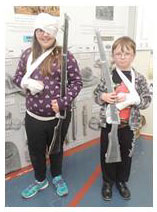
Educational programme
Nau mai haere mai nga kaiako ki te whare taonga o Te Ahu.
Welcome teachers to Te Ahu Museum.
Anei te hotaka mo nga kura katoa ki te mahia ki te whakaakonga hoki i te Whare Taonga o Te Ahu.
Museum staff will help facilitate this activity. Spin the wheel, select the right battle order equipment, dress your solider, check your survival outcome, bandage your solider, take your photo. . . children respond to this interactive learning outside the classroom.
To book contact Te Ahu Museum. Telephone: 09 408 9457
Email:
[email protected]
Koha appreciated, bookings essential.
A visit to Te Ahu Museum gives students a unique opportunity to explore and interact in the museum environment.
The learning environment at Te Ahu Museum is fun, relevant and inspiring. Programmes can take place in the Museum’s public spaces and in Te Ahu Museum.
LOOKING FLASH - Tailor-made and Home-made: clothing Kaitaia
Monday 28 September 2015 through Summer 2015 - 2016
Clothing made in and around Kaitaia.
MATARIKI EXHIBITION - Weaving in Muriwhenua
Opened on Saturday 28 June and ran until 26 July 2014
Matariki, which signals the Maori new year, has traditionally been a time to reflect on those who have passed and celebrate life, culture, language and the forthcoming year. To celebrate this Matariki, Ahipara's Te Whare Whiri Toi Gallery will stage an exhibition honouring past weavers of Muriwhenua.
The month-long exhibition, which opened at Kaitaia's Far North Heritage Museum at Te Ahu on Saturday 28 June, showcased the weaving of Te Hapua Art and Crafts and Te Rarawa Marae, Pukepoto, from 1970 to 1990, incorporating historic photographs, articles and video interviews, as well as more than 30 pieces, ranging from kete to piupiu and korowai.
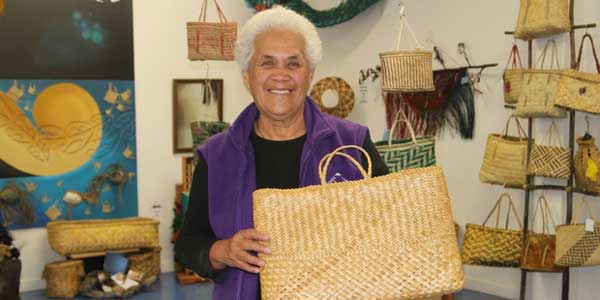
Pare Nathan with a kete from the Te Hapua collection, which will be part
of the Matariki exhibition.
PICTURE - PETRINA HODGSON
Three Displays in memory of those who server in the Great War
Opened 10.00 am Anzac Day, 25 April 2014 and ran through June.
"Letters Home" - Olwyn Ramsey has compiled a poignant storyline from the perspective of soldiers' families.
"The Fallen" - the result of Ross Beddow's deep sense of obligation to record the names and details of those from the northern region who gave their lives or were wounded and died at a later time.
"Felix von Luckner and SeeAdler (Sea Eagle)" - the story of the last fully-rigged sailing ship to be used in conflict.
"HOLY MATRIMONY - GETTING HITCHED" : The 19th Century Wedding Dress
Opened Saturday 30 November 2013 and ran through early 2014
A wedding dress is unique. For the bride it is her big day and throughout history women have tried to make their wedding gown special.
Early in the century wedding dresses were in quiet colors such as dove-grey because it was such a useful color to re-use as Sunday best, being considered imminently respectable. A few years’ later pastel colors were introduced.
Brides in cream or white are mentioned in the 1850s but colored dresses were prevalent up till 1900. Veils were not always worn although they were often mentioned from 1850 onwards. The bustle, introduced about 1870 was much less pronounced after a few years. From 1900 onwards the traditional white or cream dress and veil seem to have been to the fore. White satin shoes, stockings and gloves completed the picture.
Until the 1920s wedding dresses were always in the style of the moment, if more elaborately decorated than usual and more modest than the most daring fashion. Hemlines for ordinary wear rose from the shoe to well above the knee. At first wedding styles followed suit and brides showed their ankles, but as skirts ever more abbreviated it was felt by some to be unsuitable for a church service and brides preferred full-length gowns.
After the Second World War, when clothes and fabrics were rationed, uniforms were ubiquitous and frivolity was frowned upon. Fashion came back; everyone was keen to wear long gowns on their wedding day made from luxurious fabrics.
The Te Ahu Heritage Museum is to stage an exhibition of wedding dresses. The oldest dress on display is now 138 years old. It is made of blue figured silk trimmed with dark blue braiding. It would have been high London fashion in the 1870s. It is very fragile so will be displayed so that it can be protected from any further damaged. Apart from the above the other wedding dresses range from 1904 – 1947. A flower girl dress of 1947 completes the picture. All the gowns are part of the museum textile collection.
The staff at the museum is excited to stage this display and welcome the public to participate in the opening of this exhibition on Saturday 30 November at 2pm. We promise you a piece of the wedding cake.
We are asking that you dress formally for this special occasion. If you
are able to wear your own wedding gown, or dress as mother of the bride
or bridegroom, that had been worn at another wedding, that would be splendid.
We look forward to sharing this special occasion with you.
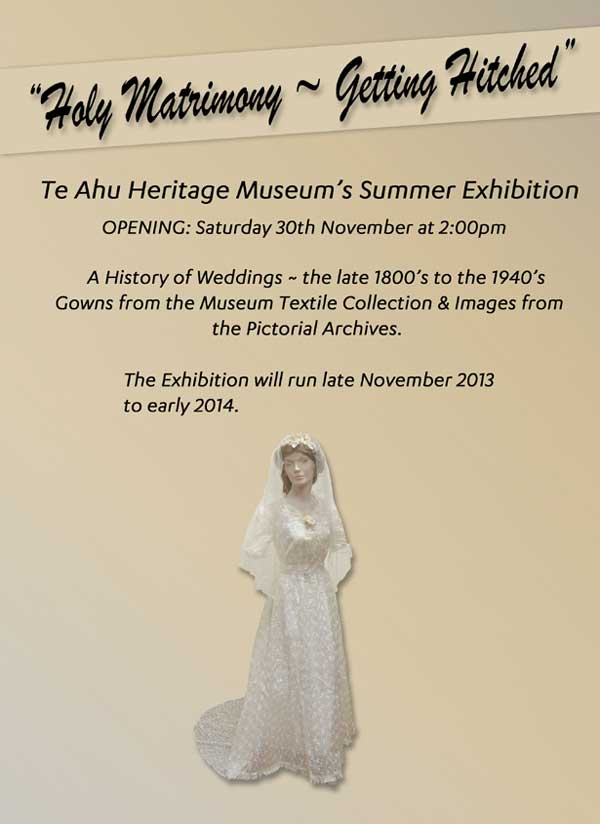
MOTUOPAO - A Green and Gold Island
Monday 9 to Saturday 28 September 2013
The exhibition opened at Te Ahu Heritage Museum on Monday 9 September 2013. It was a collaborative effort between the Museum and Kaitaia’s Department of Conservation to mark Conservation Week 2013.
The exhibition illustrated the history of the Far North’s Motuopao Island Lighthouse Station in conjunction with an insight into the ongoing conservation work being done by DOC to preserve the island’s special flora and fauna - notably the Pupuharakeke (Flax Snail) and the Robust Skink - both highly endangered species. Read more »
TANGATA FAMILY EXHIBITION
Opened Monday 4 February 2013
A tribute to the Tangata family, dating back to Himiona Tangata who was freed from slavery by missionary William Gilbert Puckey in the 1830s, commenced at 2.00pm on 4 February 2013.
The ceremony began with a welcome from museum staff and trustees and included "honouring our ancestors" stories from trustees and Te Runanga o Te Rarawa chairman Haami Piripi. The blessing and formal opening of the exhibition was conducted by Canon Dennis Urquhart.
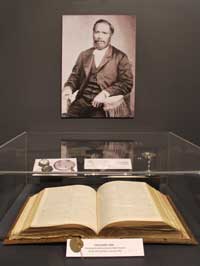
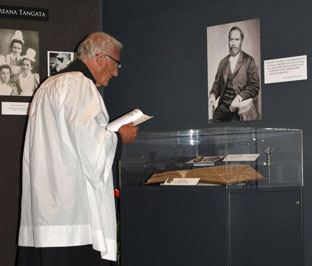
The exhibition, featuring documents, images, the silver hunter pocket watch and communion chalice used by Rev Renata Tangata and the massive family Bible he presented to Mereana in 1886, is now open to the public, while the museum is looking to other innovative collaborations.


